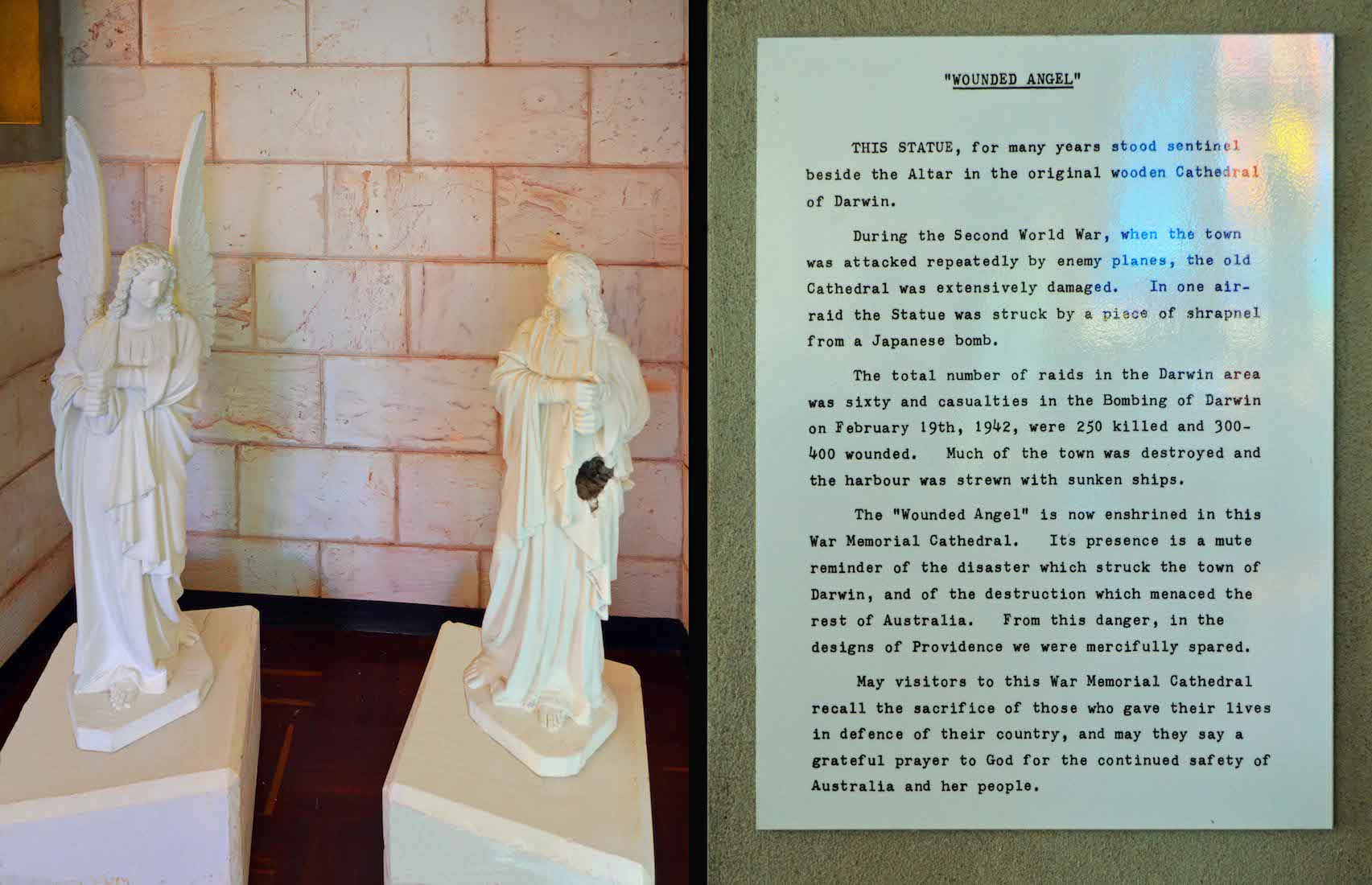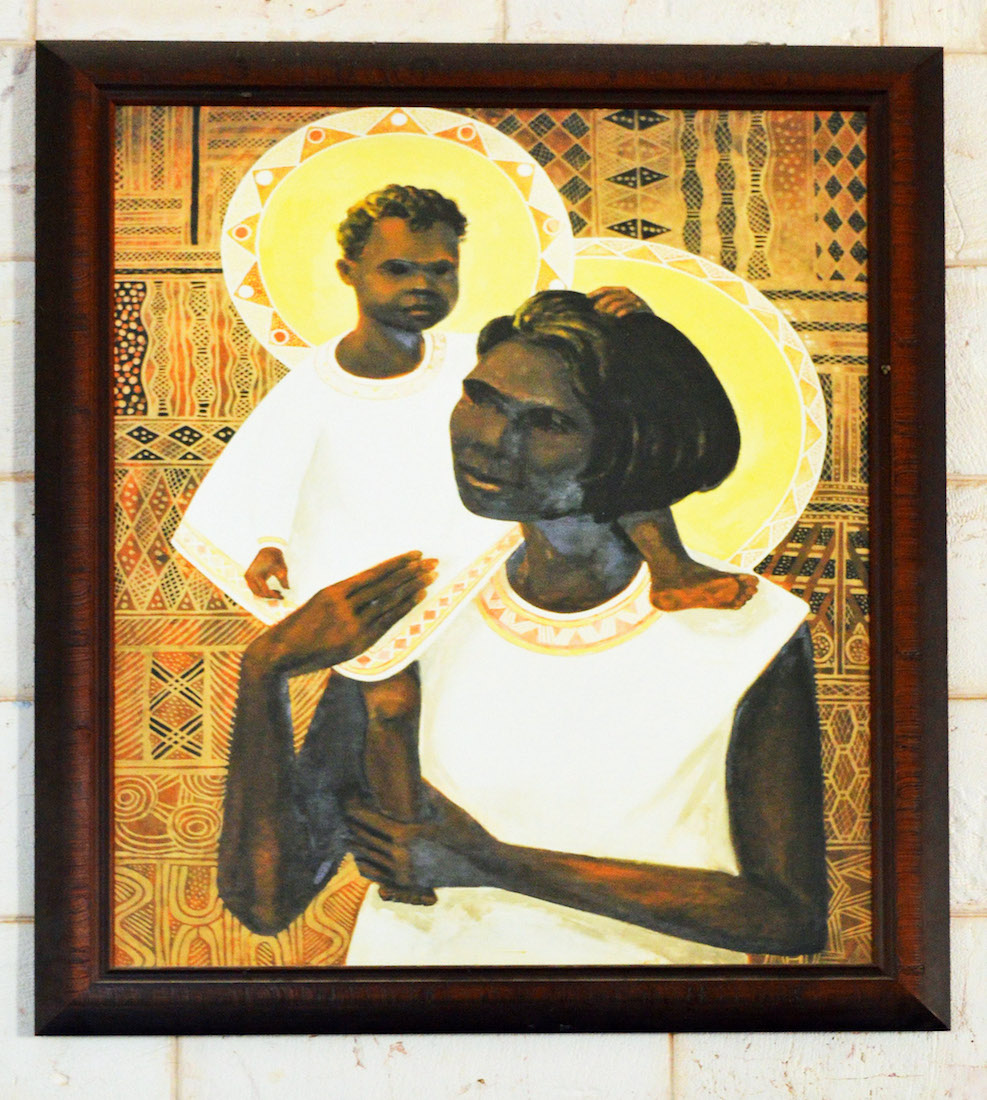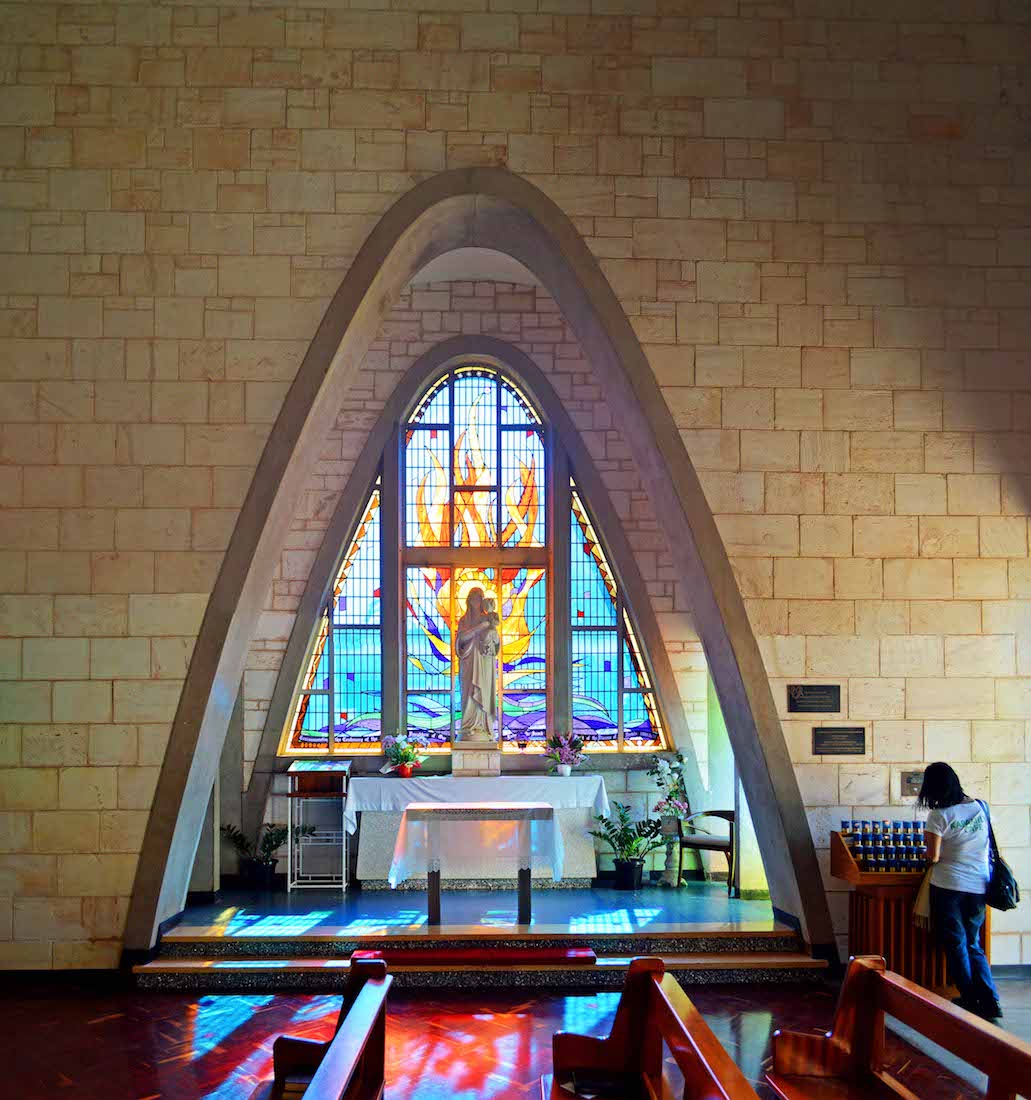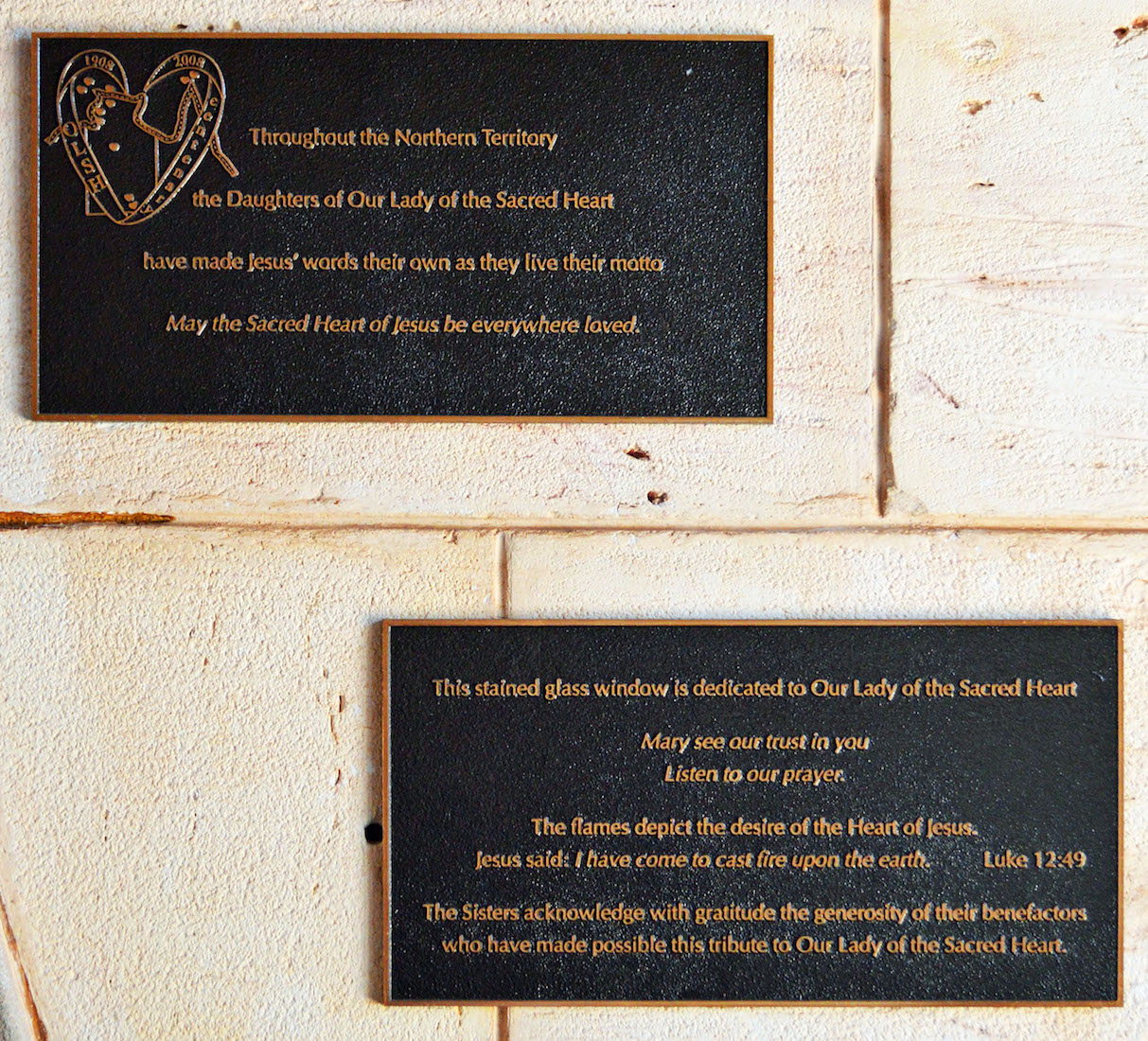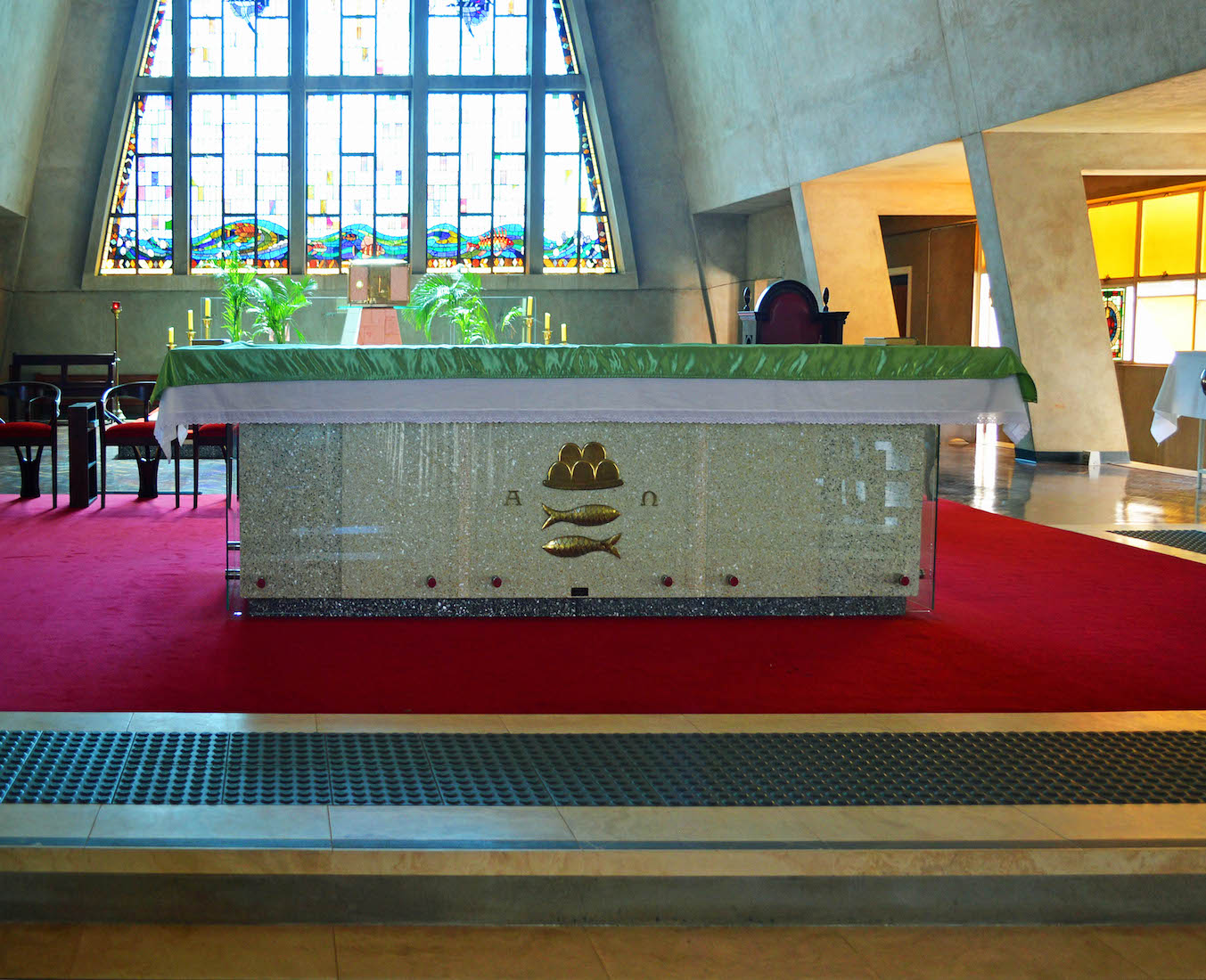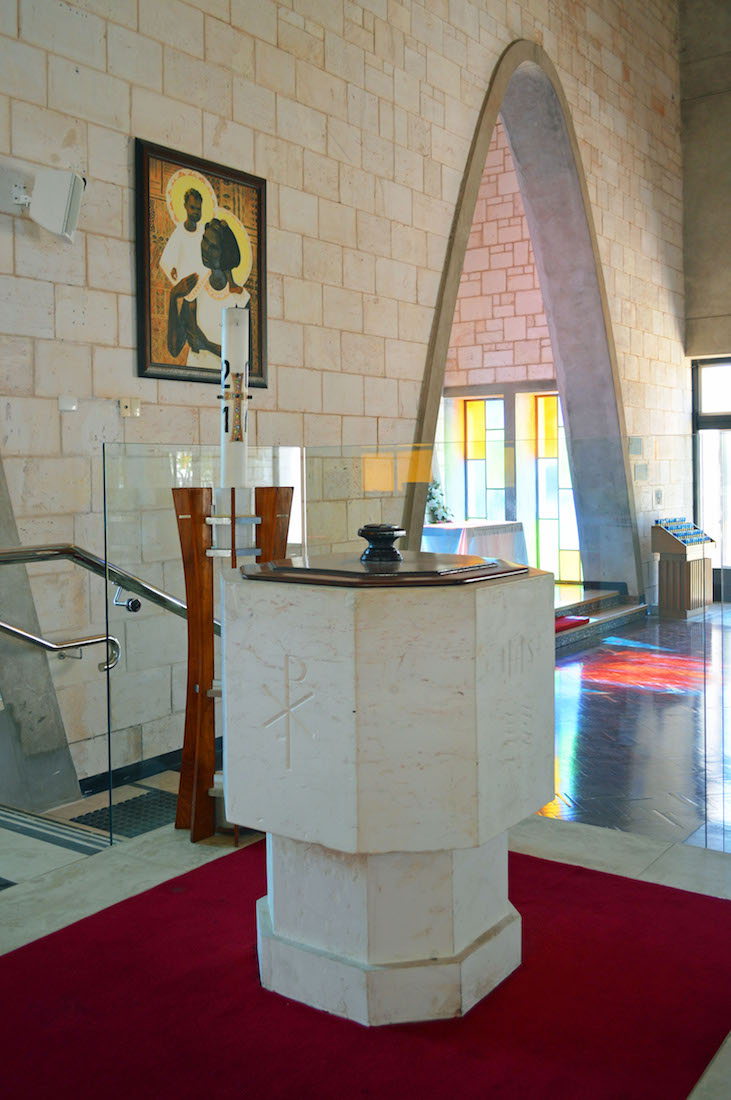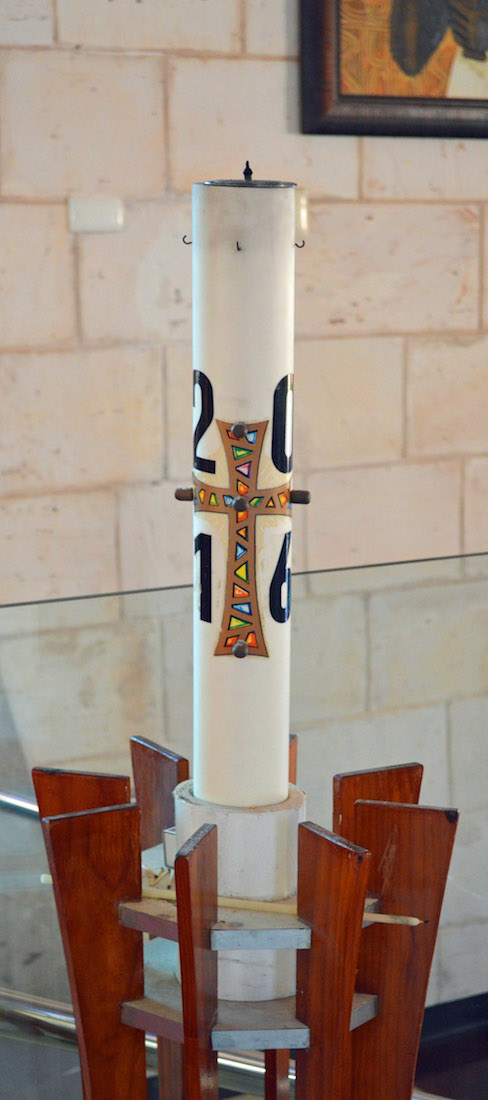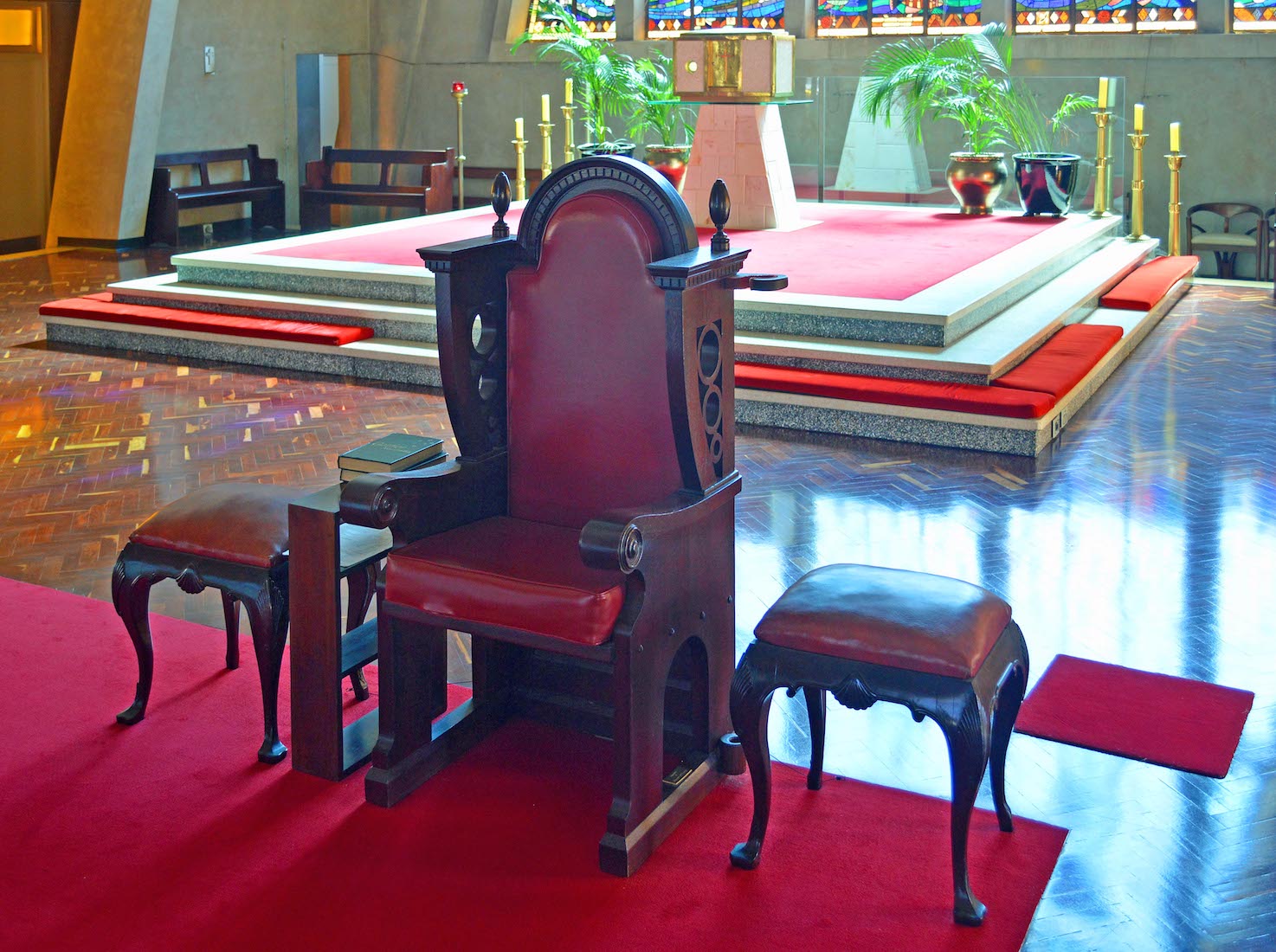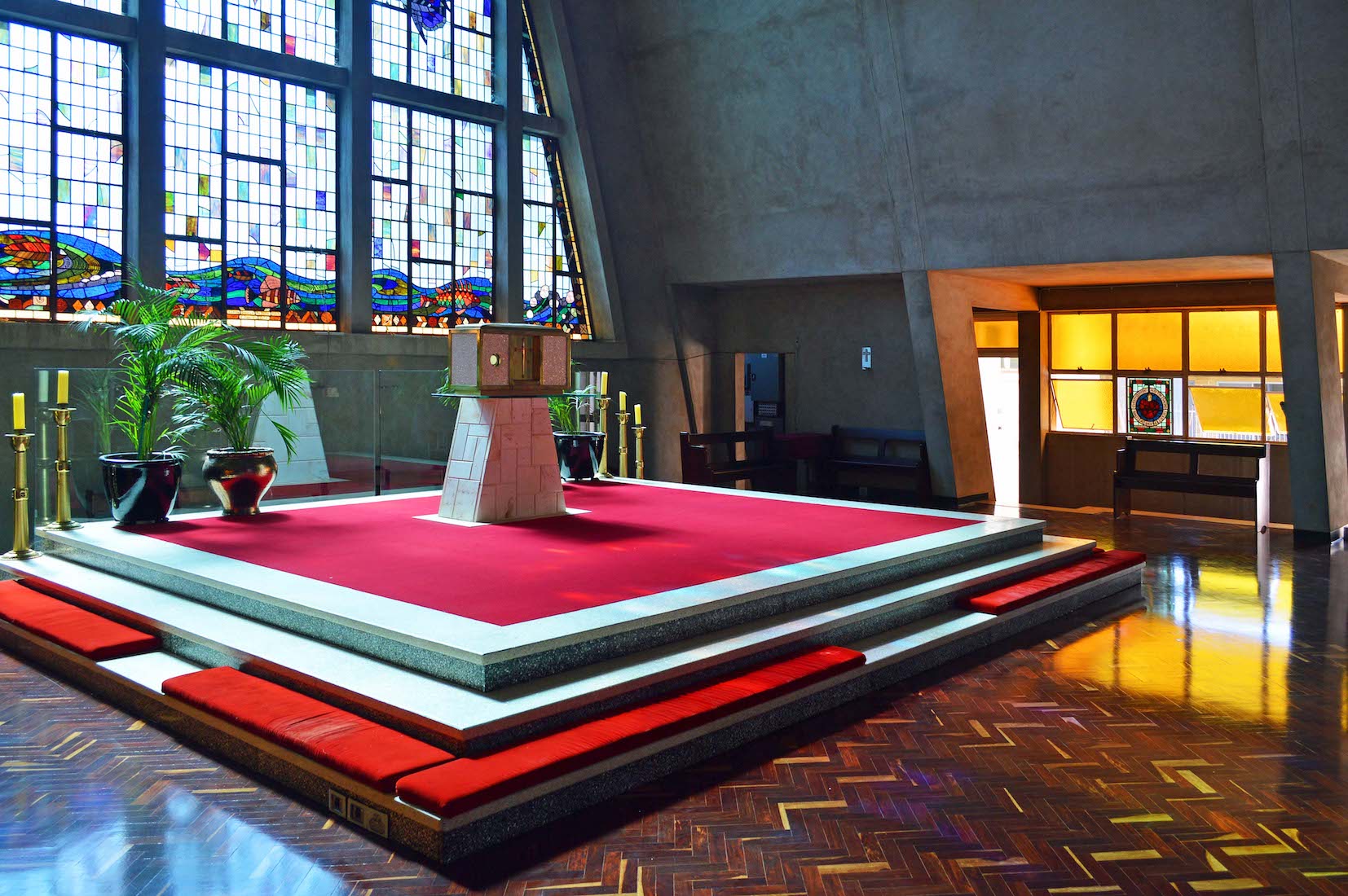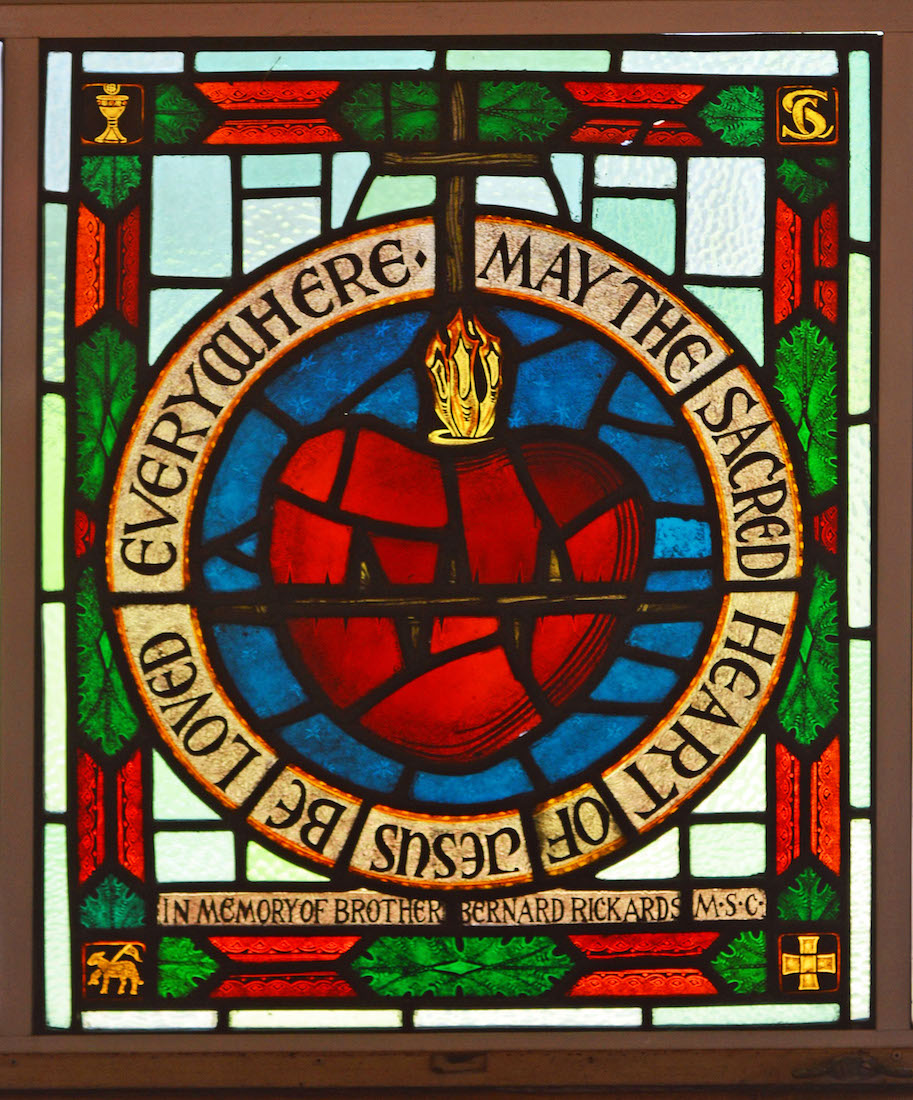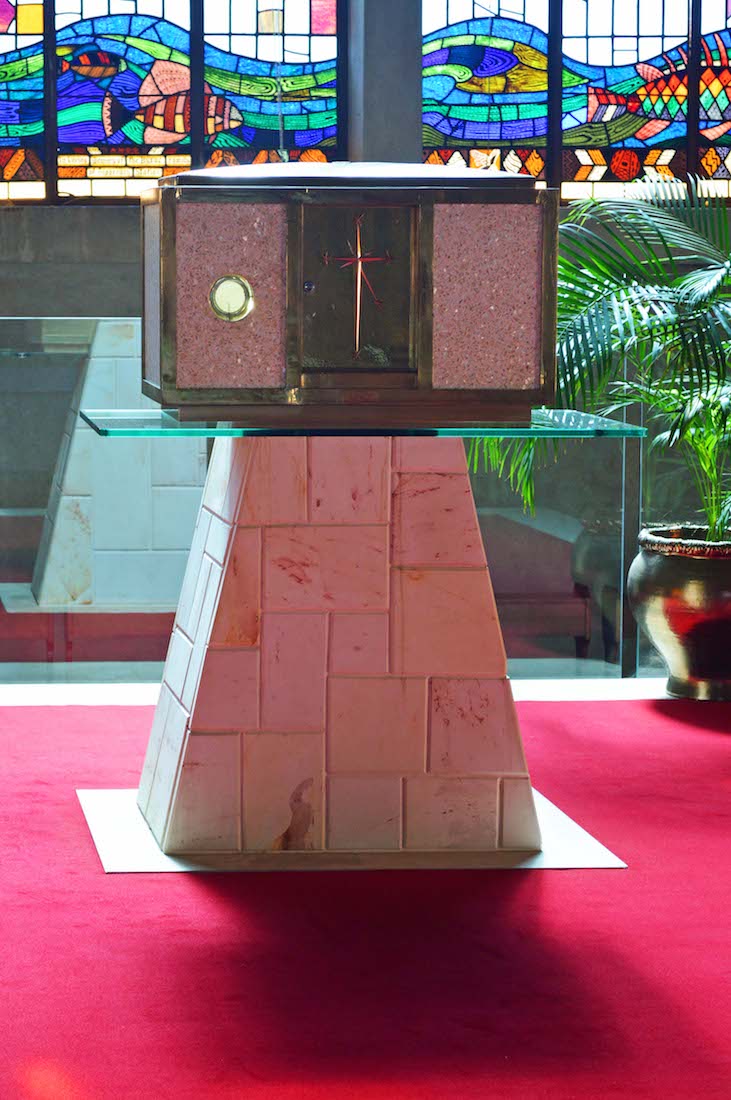
Scripture refers to Christ as the Rock of our Salvation – the firm foundation on which the Christian faith is built. The staff gives a different picture. In Western Christianity, the crosier (or pastoral staff, from the Latin pastor, shepherd) is shaped like a shepherd's crook. A bishop or church head bears this staff as ‘shepherd of the flock of God’. There is an allusion here to the title of Christ as ‘The Good Shepherd’. INDEX
42. BISHOPS’ PLAQUES

The small plaque at left reads: ‘Please pray for the deceased Bishops of Darwin, whose human remains rest in the crypt of this Cathedral’. The remaining three plaques remember (from left): Francis Xavier Gsell, Bishop 1938 – 1948; Edmund John Patrick Collins, Bishop 1986 – 2007; John Patrick O’Loughlin, Bishop 1949 – 1985.
44. WOUNDED ANGEL
This is the alcove on the right. When the Japanese bombed Darwin in 1942, ‘Zeros’ strafed the old church repeatedly with machine gun fire. Shrapnel gouged rough gashes in the altar and pierced a statue behind the altar, from front to back. The figure, despite its wound, remained unshattered. The statue became known as the Wounded Angel and today it has an honoured place in the Cathedral in this alcove.
45. ABORIGINAL MADONNA
This oil painting by European artist Karel Kupka, of the Ecole des Beaux-Arts, Paris depicts the Virgin Mary and Child as Australian Aborigines. The oil painting is 1.3 metres high and 1 metre wide. The figures are slightly larger than life-size. The Virgin Mary and Holy Child are depicted with characteristic aboriginal features and skin colour. Both are dressed in white, adorned with aboriginal designs. The Holy Child is seated on the Mother's shoulder in the typical aboriginal style of carrying an infant. Behind the heads of Mother and Child are golden haloes, painted flatly in the style of a Byzantine icon, but edged also with perimeters of authentic tribal design in red. The background of the picture is an intricate pattern of abstract totemic designs, faithfully copied from bark paintings, cave drawings and decorations of native artifacts from all tribes of the Northern Territory, Central Australia and the Kimberley. • The shrine of the Aboriginal Madonna is a focal point for Aborigines, and a reminder that the message of Christianity is universal. A print of the Aboriginal Madonna is available from the Diocesan Office.
47. LADY CHAPEL PLAQUES
The plaques emphasise the place and work of the Daughters of our Lady of the Sacred Heart, and give some information about the window. We are told that the flames depict the desire of the Heart of Jesus. My own reading of the window would be to see depicted the fire of the Holy Spirit. Perhaps the two interpretations are not too different ... .
48. HIGH ALTAR
The sanctuary and its ecclesiastical furnishings reflect the distinctly missionary background of the Diocese. The terrazzo in the altar designs and sanctuary incorporate pearl shell collected by divers from the Arafura Sea. Alluvial gold panned at the old Arltunga Mission in Central Australia is used in gilt work. The sedilia (stools) are of local cypress pine, and the parquetry floor of the sanctuary is made from ironwood (Erthophleum chlorostaches) milled at Garden Point, Melville Island.
49. BREAD AND FISHES
There is a central emblem in gold on the front of the high altar. It depicts five loaves and two fishes, recalling the story from John 6:1–14 of Jesus feeding the 5000. The Alpha and Omega symbols are from the book of Revelation, used to describe Christ. It is a fitting emblem for the altar from which the Eucharist is administered.
50. BAPTISMAL FONT
The baptismal font stands to one side of the altar. The font is made from the same porcellanite stone as the walls of the Cathedral. The font has a simple octagonal shape, and we can see on two of the vertical faces a Chi-Rho symbol, and an IHS symbol – both referring to Christ.
51. PASCHAL CANDLE
This Paschal candle has a smart decorative stand and carries the 2016 date. The candle is normally lit over the Easter period in particular. It carries the reminder that Christ is the Light of the World.
52. CATHEDRA
While a priest has authority over a single church, a bishop has authority over a group of churches, or diocese. The bishop is specially affiliated with one of those churches, and this is indicated by a special chair, or ‘cathedra’ in Latin. It is from this word, and the presence of the special chair, that the Cathedral gains its name.
53. CHANCEL
Set below the eastern wall, which is made up almost entirely of the richly coloured Star of the Sea window, and the barrel-vaulted ceiling, the chancel is in graceful harmony with the nave and transepts of the Cathedral. We notice a special stained glass panel in the far window.
54. SACRED HEART WINDOW
We have already observed the connections this Cathedral has with the Society of the Sacred Heart. This window has a central heart, with flames at the top. A surrounding ring bears the text: ‘May the Sacred Heart of Jesus be loved everywhere.’
55. TABERNACLE
The tabernacle stands at the base of the great East window. This is where the reserved Elements of the Eucharist are stored. The door of the tabernacle on the Sacred Heart Altar is of distinctive design, with two overlapping crosses, and incorporating the Southern Cross.
56. STAR OF THE SEA WINDOW
A feature of the Cathedral is the striking stained-glass East window, representing Our Lady, Star of the Sea. The artist, Mr William Bustard of Brisbane, has brought this out by placing a star atop the window from which rays radiate downwards. Immediately under the star is a representation of the Madonna and Child. Then there is an expanse of sky through which three seabirds are flying, and underneath a symbolic representation of the sea with fish, and waves in blue. Three cherubs decorate the apex of the window. One is black to represent the Aborigines among the congregation. The window was donated to the Cathedral in memory of relatives of the Byrne brothers of Tipperary Station. This completes our tour of this Cathedral.
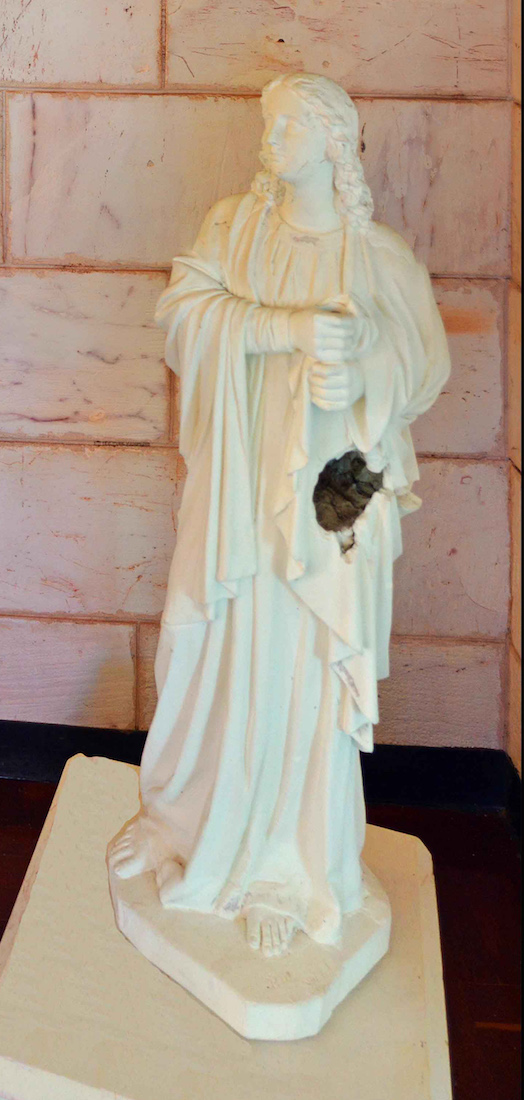
CONCLUSION
I hope you have enjoyed visiting the St Mary Star of the Sea Cathedral, Darwin, with me. It has a number of unique features, and it was a pleasure to photograh it.
I am happy to receive constructive comments or corrections concerning this website. The best websites are the ones which have no errors! I am grateful to my wife Margie who came to Darwin with me, and who has proof-read these pages.
The photographs are almost all mine, but the text comes from a variety of sources, and I gratefully acknowledge these.
The Darwin Diocese has a website with link:
http://www.darwin.catholic.org.au/
The photographs which appear on this site can also be found in higher resolution at:
https://www.flickr.com/photos/paulscottinfo/albums/
Site created 08 / 2016 ; reformatted 09 / 2020
Paul Scott


